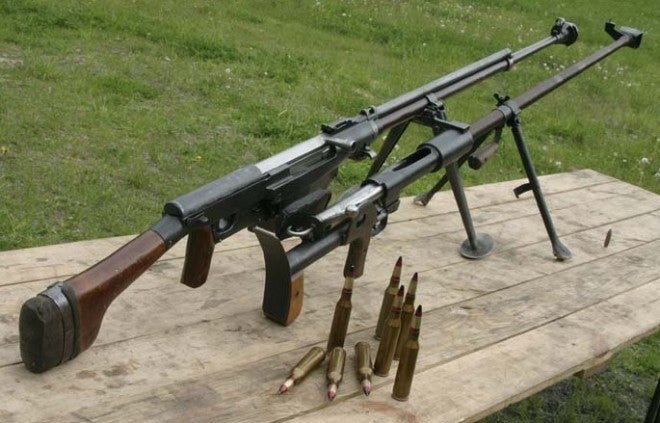The Simonov PTRS 14.5mm anti-tank rifle was a very innovative rifle, that seemingly offered the Soviet AT gunner of the early part of World War II a frightening amount of firepower. Its semiautomatic action, and en-bloc clip loading gave the infantry five rounds of high velocity heavy AT rifle ammunition on tap, that could be fired as fast as the trigger could be pulled and the target reacquired. By comparison, the contemporary single-shot Degtyarev PTRD seems downright crude. However, as this evaluation translated by EnsignExpendable of the Soviet Gun Archives blog shows, things are not always how they seem:
“Evaluation of Degryaryev and Simonov anti-tank rifles based on the reviews of privates, Sergeants, and officers of anti-tank rifle units
- Simonov’s rifle starts jamming after only a small amount of fouling in the chamber, after 10-15 shots. Degtyaryev’s rifle is flawless in its action. I knocked out a tank near Skopishki at 300 meters (with a BO-32 bullet). – Sergeant Pazharduk, 665th Reg., 216 Div.
- The Degtyaryev anti-tank rifle has an insufficient rate of fire for fighting tanks, reloading takes too long. The rate of fire of Simonov’s rifle is good, but heavy for attacking. Their weakness is that they are not used with the whole unit, but split up among companies and platoons, which removes the ability to fire in groups on tanks and other targets. BO-32 bullets have weak incendiary properties, BO-41 bullets are good. – Sergeant Pikalov, 346th. Div.
- The PTRD is an excellent weapon, works flawlessly. The PTRS jams often when there is any dirt in it or when the lubricant freezes. – Artillery Quartermaster, 1166th Reg., 346th Div. Jr. Military Technician Prikhodko
- The PTRD is flawless in battle, never has any jams that create difficulties on the battlefield. However, its weakness is that it has no magazine. The PTRS has a high rate of fire, and is convenient to carry, as it can be taken apart and put back together quickly. Its drawback is that it has many jams that cannot be fixed on the battlefield, the assembled rifle is heavy, the round casings burst often, and the chamber is fouled, which results in jams. 4 medium tanks were knocked out with anti-tank rifles from 300 meters (BO-41 bullet), and three armoured cars from 200 meters. – Artillery Quartermaster, 1168th Reg. 346th Div.
- The PTRS has sufficient rate of fire, and sufficient penetration for a light or medium tank. Its drawbacks include jamming in dusty conditions and case expansion, which makes reloading difficult.
The PTRD is light and mobile, reliable in cold and dust. The penetration is sufficient. Drawbacks include a lot rate of fire. During fighting in Lithuania and Latvia 3 tanks were knocked out at a range of 250-300 meters with incendiary bullets. – Commander, 1st Company, 1168th Reg. 346th Div. Captain Gotozhkov- The PTRD is superior to the PTRS, its penetration is good. With three aimed shots, an enemy machinegun was destroyed at 250 meters. Company commander, 346th Div. Sr. Lieutenant Deritz
- The anti-tank rifle is a good weapon for destroying enemy strongholds, armoured cars, and other weapons. – Sr. Sergeant Fedoseev
- The penetration of the anti-tank rifle at 100 meters is 45 mm. The rate of fire of the PTRS is 10-15 RPM, of the PTRD is 8-10 RPM. The rate of fire is good. The anti-tank rifle is very effective at destroying enemy machinegun nests. The anti-tank rifle likes cleanliness, good care, and constant lubrication. – Jr. Sergeant Kvichko
- Anti-tank rifle units prefer to be armed with PTRD rifles, as they are lighter and more reliable. Currently, AT rifles are rarely used against tanks, as our units are saturated with AT artillery. They are normally used to destroy cars, prime movers, and light armoured cars. – Artillery Quartermaster, 417th Div. Malinin
Conclusions
- In the second phase of the Patriotic War, when the Red Army went on the offensive on all fronts, our forces became saturated with AT artillery, improvement of armour on medium tanks and increased numbers of heavy tanks, the importance of anti-tank rifles as anti-tank weapons decreased drastically.
The anti-tank rifle lost its power as an infantry anti-tank weapon. Artillery effectively fights tanks now. The anti-tank rifle, due to its high precision, is now used against open enemy concentrations, armoured cars, and APCs. This is natural, given the state of equipment of infantry at this time.- Almost all anti-tank rifle units speak well of the PTRD: light to carry and flawless in battle. Some wish to increase its rate of fire, others mention that the rate of fire is the only good quality of the PTRS. There are no positive reviews of its reliability, only negative. After 10-15 shots, it starts jamming, and these jams are hard to fix, consume a lot of time, which is unacceptable in modern fast-paced battle.
The PTRS is unusable in battle, and its subsequent production is pointless.- Retain the PTRD in production, increase its rate of fire.
51st Army HQ Chief, Major-General DashevskiyChief of the Artillery HQ, Colonel ShvedkovSeptember 28th, 1944″
While dithering over which obsolete anti-tank rifle is better may seem trivial by 1944, the Soviets had discovered that the rifles were extremely useful for attacking softer targets, such as trucks, light armored vehicles, airplanes on the ground, and sensitive static targets like fuel depots. Further, although generally speaking the armor thickness of German tanks increased greatly from 1941 to 1944, many of their tanks remained vulnerable to AT rifles at close ranges, including, if the shooter were lucky and hit the right spot, some marks of the Panther tank. The finicky PTRS, however, was not a total failure: The highly successful Simonov SKS intermediate-caliber carbine was directly based on the PTRS’s design.
 Your Privacy Choices
Your Privacy Choices
